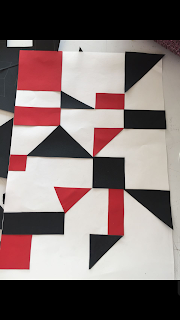THE ORIGIN OF THE WORK OF ART Martin Heidegger
We can observe that, in an obvious sense, the artist is the origin of the work; but we can also say that the work is the origin of the artist as such without the work the artist would not be an artist.
Art is the origin of both artist and work.It is common to think of the work in its thingly character as a base for the symbolic function of the work, in virtue of which it points beyond itself.
Thing and Work.
In the history of Western metaphysics, the previously dominant conception of the thing was based upon a certain interpretation of equipment. To get beyond the history of Western metaphysics, we need another ontological interpretation of "the equipmental being of equipment." We'll take this interpretation from Van Gogh's painting of a woman's shoes. The world of the woman comes forth in this work ,the ways of her life upon the earth. "The artwork let us know what shoes are in truth"; in the work of art the truth of an entity has set itself into work.
This thought departs from the aesthetics of beauty and seems to revert to a theory of "imitation," but a Greek temple imitates nothing; nevertheless, "truth is set to work in such a work, if it is a work" .To begin an inquiry into art by starting with what seems most obvious the thingly character of the work presupposing traditional concepts of the thing is an approach that runs aground. Instead we need to approach the concept of thing by beginning with the concept of the work and how truth happens in the work.
The Work and Truth
The origin of the art work is art.
It would seem as though, to see the work, we must see it in isolation from everything else, for example, as in great art, where the artist does not obtrude, does not manifest in his or her idiosyncrasies, but disappears in the work.
The work is not like a tool in which material remains in the background and is used up; in the work the rock and metals and colors and tones and word appear as what they are. Between world and earth, between the holy and the unholy, between opponents, there is a striving. Understand the striving deeply. The self-assertion of nature in the work is "never a rigid insistence upon some contingent state, but surrender to the concealed originality of the sources of one's own being"
o see how truth happens in the work we need a deeper concept of truth. It refers to what is essential, but essence is not understood in terms of "Platonic" forms. Nor is truth merely a matter of correctness, of conforming to the way things are; this derivative conception of truth presupposes the deeper conception: that things are unconcealed, that they appear as what they are.
The question, the inquiry, advances now, asking about the creation of the work: "How does the impulse toward such a thing as a work lie in the nature of truth? Of what nature is truth, that it can be set into work, or even under certain conditions must be set into work, in order to be as truth?" In other words, what is it about truth that impels the creation of art works? And why does truth need art to be itself? The world is the clearing of the paths of the essential guiding directions with which all decision complies.
Truth and Art
Art works are created, not, however, simply through craftsmanship by a particular artist, but as the knowing bringing forth of beings into unconcealedment. Art is something that Being lets happen; it is not simply an affair of one of the many beings.
Truth happens in art, in the founding of a political state, in the nearness of that which is not simply a being, but the being that is most of all. Truth is never gathered from objects that are present and ordinary.If we have a deep enough understanding of language, we can say that all art is essentially poetry, bringing something that is into the Open.
A work is in actual effect as a work only when we remove ourselves from our commonplace routine and move into what is disclosed by the work, so as to bring our own nature itself to take a stand in the truth of what is.

Comments
Post a Comment